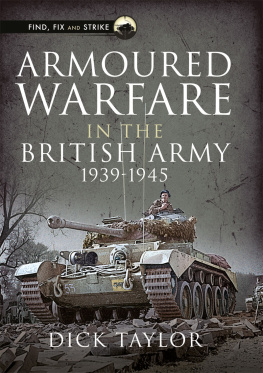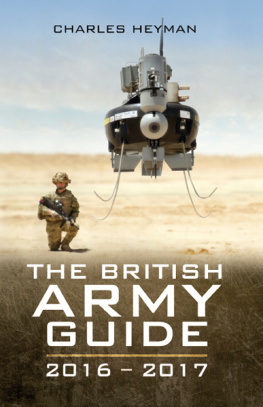First published in Great Britain in 2016 by
Pen & Sword Military
an imprint of
Pen & Sword Books Ltd
47 Church Street
Barnsley
South Yorkshire
S70 2AS
Copyright James Goulty 2016
ISBN: 978 1 78159 298 4
PDF ISBN: 978 1 47387 507 4
EPUB ISBN: 978 1 47387 506 7
PRC ISBN: 978 1 47387 505 0
The right of James Goulty to be identified as the Author of this Work has been asserted by him in accordance with the Copyright, Designs and Patents Act 1988.
A CIP catalogue record for this book is available from the British Library
All rights reserved. No part of this book may be reproduced or transmitted in any form or by any means, electronic or mechanical including photocopying, recording or by any information storage and retrieval system, without permission from the Publisher in writing.
Typeset in Ehrhardt by
Mac Style Ltd, Bridlington, East Yorkshire
Printed and bound in the UK by CPI Group (UK) Ltd,
Croydon, CRO 4YY
Pen & Sword Books Ltd incorporates the imprints of Pen & Sword Archaeology, Atlas, Aviation, Battleground, Discovery, Family History, History, Maritime, Military, Naval, Politics, Railways, Select, Transport, True Crime, and Fiction, Frontline Books, Leo Cooper, Praetorian Press, Seaforth Publishing and Wharncliffe.
For a complete list of Pen & Sword titles please contact
PEN & SWORD BOOKS LIMITED
47 Church Street, Barnsley, South Yorkshire, S70 2AS, England
E-mail:
Website: www.pen-and-sword.co.uk
Contents
List of Plates
Acknowledgments
F or agreeing to this project I thank Pen & Sword Books Ltd, and I am very grateful for the editorial support provided by Jen Newby, Eloise Hansen and my copy editor Stephen Chumbley. I also thank Lisa Hooson for her assistance with the illustrations. The staff at Tyne and Wear Archives, Durham County Record Office and Lincoln Central Library all offered welcome assistance and made research visits more pleasant. I thank the librarians at Newcastle City Library who were most helpful, particularly in digging out regimental histories from their store of reference works. Similarly, I thank Helena Bates and her staff at Wylam Library, Northumberland, who were kind and supportive, particularly when looking for books in their local history section.
Paul Ternent and the staff at Northumberland Record Office provided encouragement and assistance, especially when dealing with the oral history interviews. I am extremely grateful to Adrian Wilkinson and the staff at Lincolnshire Archives, not least for providing a draft catalogue of material relating to the Lincolnshire Regiment, and for being so efficient when ordering material on research visits.
It was a privilege to speak to the following wartime veterans during the course of my research: Bill Moylon; Bob Killer Taylor; Bill Titchmarsh at Royal Hospital Chelsea; Bill Ness; and George Henderson from Newcastle upon Tyne. My thanks to David Bell (County Secretary Northumbria) and David Hayley (Chairman Newcastle Central Branch) of the Royal British Legion for putting me in touch with the latter two veterans.
Professor David French offered support, and I am especially grateful to him for alerting me to the availability of the Imperial War Museums oral histories online. Likewise, I am indebted to former Royal Northumberland Fusiliers officer Sam Phillips, for drawing my attention to John McMannerss excellent memoir Fusilier Recollections and Reflections 193945 (Michael Russell Ltd, 2002).
Every effort has been made to use short quotes from printed sources in keeping with the guidelines on copyright. A full list of materials consulted during research can be found in the bibliography. The illustrations are sourced from the authors collection, and for their assistance in compiling this I thank: Clive Hardy; John Turner; Simon Murdoch (Tansy Murdoch Collection); and the staff at Fieldstaff Antiques, Rochester. For allowing me to photograph wartime military vehicles and equipment at their events and museums, I am indebted to the North East Military Vehicle Club, Muckleburgh Military Collection, Norfolk, and 2014 Victory Show, Leicestershire.
Last but not least I thank my family and Poppy the Boxer dog for their unstinting love and support during the research and writing phases of this book.
Introduction
T he Second World War remains one of the most momentous events in human history. It claimed the lives of an estimated fifty million people, and inflicted physical or mental injury on countless more. Simultaneously, many areas of civilisation were ruined around the globe and the conflict led to the Cold War, the ramifications of which we are still facing today. This book focusses on the experiences of wartime British soldiers who fought in a variety of theatres, and women who served with the Auxiliary Territorial Service (ATS). They came from a generation that had grown up in the shadow of the First World War, and a Britain that had not yet relinquished her position as an imperial power. Many volunteered, but equally the army became increasingly reliant on conscripts as the war progressed, some of whom proved more willing warriors than others.
In September 1939 the British Army was unprepared for war, particularly one against a major European power such as Germany that involved modern weaponry and tactical innovations. Reflecting on the fall of France and the Low Countries in May/June 1940, Field Marshal Bernard Montgomery later commented, to our shame we sent our Army into that most modern war with weapons and equipment which were quite inadequate, and we only had ourselves to blame for the disasters which early overtook us in the field when fighting began. Yet, by 1944 the army had evolved into an effective fighting force, that ultimately emerged victorious as part of the overall Allied war effort. This was despite lacking, what former American Army officer and historian Carlo DEste described as, the soldierly instincts that characterized the German Army.
beyond merely imparting the basic grammar of military service. In the twentieth century it was widely used by armies to counter boredom within the ranks, and acted as a means to instil professional pride. Training also generated unit cohesion, when groups of soldiers trained together and went into battle together led by officers who had been responsible for that process.
Finally, as Hew Strachan highlighted, training could help soldiers assimilate changes in tactics and master new technologies. As illustrates, battle drill was introduced by the British Army during 1941, and built upon previous teachings. It became an effective means of imparting an understanding of basic infantry tactics amongst wartime soldiers, and helped them cope psychologically with the pressures of combat.
As the war continued, the army had also to consider how it selected soldiers for training in particular trades, such as signallers and drivers needed to support the expanded wartime force. Likewise, the selection and training of sufficient officers to lead wartime units was a pressing concern. considers these issues via the experiences of ordinary soldiers who undertook wartime selection processes or officer training.
The role of women is highlighted by two chapters. on casualties and medical matters acknowledges the immense contribution of the Queen Alexandras Imperial Military Nursing Service, particularly in caring for soldiers in hospitals overseas.
Understandably the Second World War is often portrayed as a war of movement. The German victories in Poland (September 1939), Norway and Denmark (April 1940), and France (June 1940) demonstrated the potency of Blitzkrieg tactics, at the heart of which was the effective synergy between airpower, armour, and mobile infantry and artillery units. The see-saw nature of the campaigns in the North African desert during June 1940May 1943 were highly dependent on armoured forces, and further reinforce the view that combat during the war was often fluid and dynamic. However, as with the stalemate conditions that characterised the First World War on the Western Front than is popularly appreciated.
Next page


















